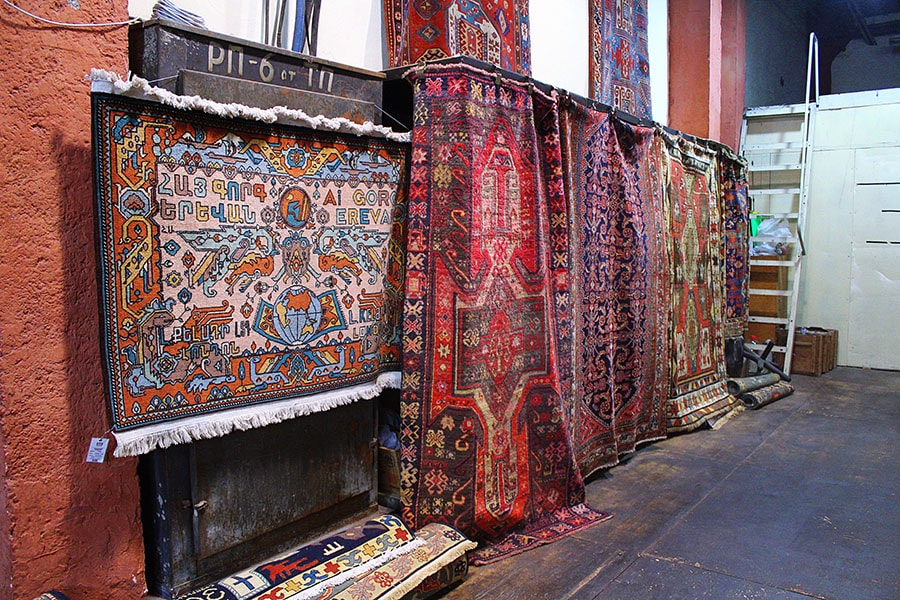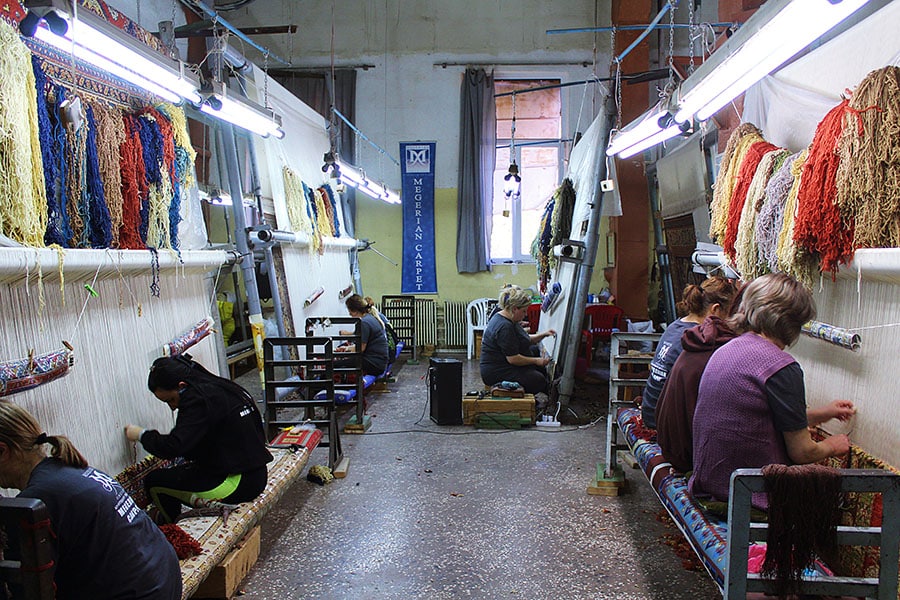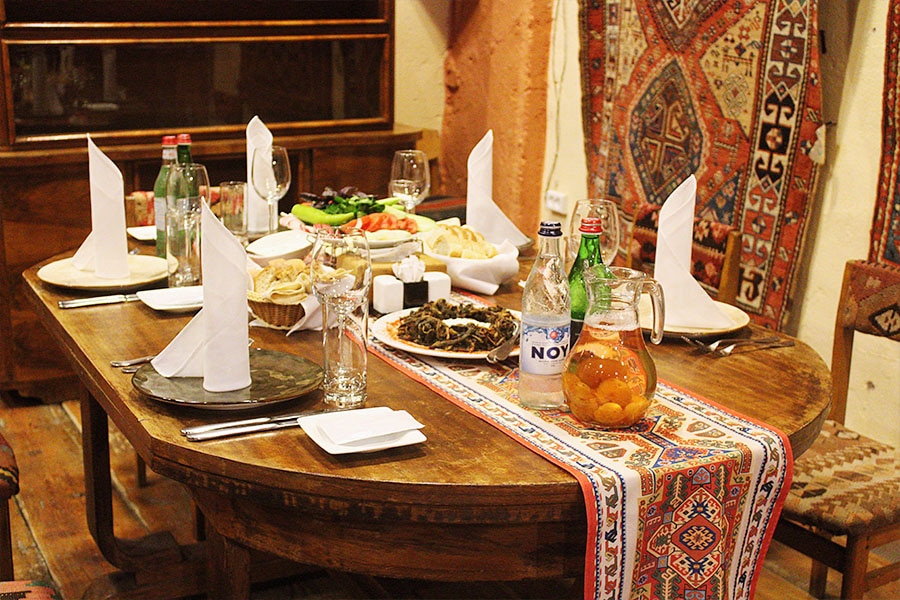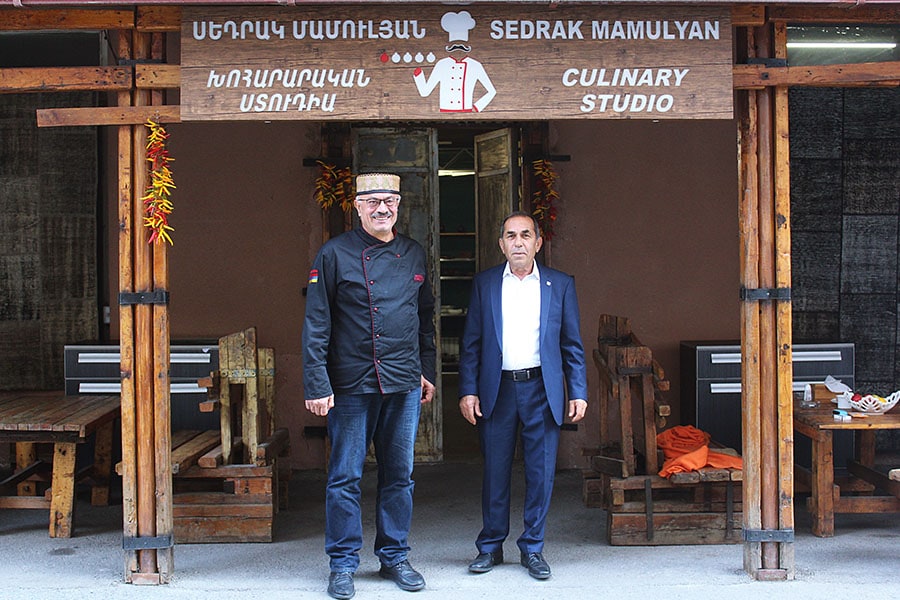More than just a craft, in Armenia carpet-making is a tapestry of the country's
Megerian carpets grace the floors of renowned churches in the world and the homes of esteemed figures, including the Queen of England, and presidents of many nations


Nestled on Madoyan Street, a mere 10-minute drive from Republic Square, the bustling heart of Yerevan, the Megerian Carpet Cultural Complex houses a factory, a museum and a culinary school, all of which offer a glimpse into the world of 100-to-400-year-old Armenian rugs and carpets. In Armenia, the art of carpet weaving has been passed down through generations, each stitch preserving a thread of the country’s rich heritage, and the Megerian family stands as a testament to this enduring tradition, proudly perpetuating its legacy for all to admire.
The Megerian Carpet Factory was established in 1917 in New York City by Hovannes John Megerian, the grandfather of today’s owners. Back then, Megerian was involved with washing, buying and selling, and repairing of antique rugs. Three decades later, they boldly ventured into reproduction. The company was passed on to his children and in the 1970s they opened factories all over the world, though now they only have two—in New York and Yerevan. In 2002, the Megerian family acquired Aygorg Union, a Soviet-era rug-weaving company in Armenia that used chemical dyes and the Persian one-and-a-half knot technique. They completely revamped the company"s production methods, switching to all-natural organic dyes and the Armenian double knot technique, the world"s oldest knotting technique. The Armenian double knot technique, in contrast to the more common Persian one-and-a-half knot technique, only becomes tighter as it is pulled.
Fast forward to today, the company is one of the biggest makers of traditional Armenian rugs, whose motifs and designs whisper echoes of centuries past. They also make vast rugs, some reserved for momentous occasions, others that grace the halls of presidential palaces, churches, and other important landmarks. And it is here, within the walls of the complex, that Megerian’s craftsmanship and artistry unite in a symphony of colours and patterns, where one can marvel at the making of unique carpets and even buy them.
 The Megerian Carpet Factory Museum Image: Veidehi Gite
The Megerian Carpet Factory Museum Image: Veidehi Gite
At the entrance, Raffi Megerian, the third-generation owner of Megerian Carpet Cultural Complex, directs our attention to an Armenian alphabet door gracing the entrance. He highlights the uncanny resemblances between the Armenian and Indian Sanskrit alphabets and the interconnectedness of cultures. Stepping into the confines, the interiors pulsate with earthen pots, antique tapestries, and a display of coloured wool encased in a glass case. The sheer magnificence of the vintage carpets that grace the floors in room after room of the museum make you ponder if you can even walk over them. But Galina, the museum guide assures us, “There is an Armenian saying that the carpets are meant to be walked upon. We clean these rugs once every six months with cold water and a special soap which is made of natural oils." Megerian’s renowned designs find their origins and inspiration in these ancient carpets, which serve as both the wellspring and blueprint. In doing so, they proudly preserve the rich tapestry of Armenian heritage.
 An Armenian carpet at the Megerian Carpet Museum showcasing traditional motifs Image: Veidehi Gite
An Armenian carpet at the Megerian Carpet Museum showcasing traditional motifs Image: Veidehi Gite
Arranged on a turquoise boat-shaped table in the first room of the factory, a collection of six natural dyes reads like a poetic recipe: bark of the mulberry tree for beige colour, indigo (imported from India) for the blue colour, the root of madder for red colour, rind of pomegranate from Megri for coffee and black colour, immortal flower (a type of wildflower that grows in the mountains) for yellow colour, and walnut shell for brown colour. “These humble ingredients, when skilfully combined, give birth to a staggering array of nearly 600 shades," says Galina. In ancient times, Armenian carpet weavers obtained red dye from the cochineal insect, a type of red beetle. Today, she adds, cochineal dye (Vordan Karmir) is very expensive, so madder root is often used instead, including to paint Easter eggs red. “Alum (mineral) and wine stone (leftover wine that becomes stone over the years at the bottom of the barrel) are two fixators that are used to fix the colours to the wool. We use two more fixators which are a trade secret. This formula keeps colours vibrant and prevents them from fading."
 Antique carpets from Armenia, 100 to 400 years old, at the Megerian Museum Image: Veidehi Gite
Antique carpets from Armenia, 100 to 400 years old, at the Megerian Museum Image: Veidehi Gite
A group of 40 skilled female weavers diligently operates the looms in the factory. Some of them have worked here for over a decade. Qnarik has been weaving for over 20 years, while Anush and Ripsinp are also experienced weavers. Each meter of rug takes a minimum of two months to weave, depending on the complexity of the design. A single square meter of rug contains 1,60,000 Armenian double knots. Each loom has its own map, which is a grid of tiny squares, each representing one Armenian double knot. Weavers weave row by row, using a tool called a Ktut to secure the knots after each row is complete. Megerian sources old Armenian carpets from around the world and recreates their designs on new carpets.
“We have several small looms but only one large power loom that can weave rugs up to 100 square meters in size. These eco rugs take three years to weave and require 4-6 women to work on them simultaneously. We typically do not sell these large rugs, as they are woven for special occasions and placed in presidential palaces, churches, and other significant locations. Some of these rugs are even donated," says Raffi Megerian adding, “We keep the price of these rugs very reasonable and confidential, but it is estimated to be around $500-$1000 per square meter. We have woven rugs for the Vatican, the largest of which was 100 square meters."
 Megerian Factory"s workforce includes 40 female weavers Image: Veidehi Gite
Megerian Factory"s workforce includes 40 female weavers Image: Veidehi Gite
Their high-quality production process involves washing the carpets 4-5 times and combing out the extra wool fibres to prevent shedding when the carpets are taken home. “The final product is perfectly shiny and smooth wool that will last for generations. Like the Armenian carpets my grandfather left us, these carpets are unique works of art that are worth the investment. We use only the highest quality, hard lamb wool in our rugs. Once the rugs are finished, we turn them over and place them on the floor. We then spray them with a special natural insect repellent made from tree bark, flowers, and roots from the Armenian mountains. This protects the rugs from moths and other pests," he adds.
Ancient Armenian carpets were meticulously crafted by independent weavers, each piece infused with their cultural heritage, historical narratives, social perspectives, and personal anecdotes. The newly created carpets serve as faithful replicas of those designs, preserving the essence of those weavers expressions and experiences. All the rugs in the Megerian Carpet Museum are at least a hundred years old. A large worktable in the museum displays a carpet that was woven for the 2,800th anniversary of Yerevan in 2019. Four craftsmen worked for over a year to create the carpet, which depicts some of the most important events in Yerevan’s history. Other notable rugs on display include the Tiknani carpet from 1898 with intricate floral patterns, the Khndzoresk from 1928, illustrating a scene from the Armenian village of cave dwellings, the Sisian Rug (a 20th century rug with traditional Armenian motifs) and the 19th-century Tree of Life, which is a common motif in Armenian art and culture.
 This is the oldest carpet in the collection, a 400-year-old Vaspurakan carpet from Western Armenia, dating back to the 16th century Image: Veidehi Gite
This is the oldest carpet in the collection, a 400-year-old Vaspurakan carpet from Western Armenia, dating back to the 16th century Image: Veidehi Gite
The oldest, a 400-year-old carpet, is a 16th-century Vaspurakan carpet from Western Armenia, a near perfect example of the superior processes used in Armenian carpet-making. The left part of the carpet was restored in Soviet times with the help of chemical dyes and is very different from the colouring on the right side, which was neither damaged nor restored. It’s a nod to the fact that yarn dyed with natural colours never loses its vibrancy. A Lori carpet, a replica of the original held in the treasury museum of the Holy Etchmiadzin, the spiritual centre of the Armenian Apostolic Church, is also on display. The carpet has been reproduced six times, not for sale, but to be gifted to individuals who have made significant contributions to Armenia"s development. Five have been gifted—to Pope Francis, Charles Aznavour, footballer Henrikh Mkhitaryan, Catholicos of Cilicia Aram I, and Turkish MP Garo Paylan. Another Lori carpet was woven for George Clooney.
Most rugs have a unique story, and some are even symbolic. For example, the 160-year-old Vahan (shield) rug is a symbolic artefact of the Armenian Genocide. In 1915, a mother divided their family carpet into two pieces and gave one to each of her daughters, telling them that if they were ever separated, they might be able to find each other again someday with the help of the rug. Fifty-three years later, the sisters were reunited in New York City, thanks to the two pieces of the rug. In 2017, the Megerian family also donated two of their Armenian rugs to the Armenian Patriarchate of Jerusalem and the St. James Brotherhood. These rugs are placed on the altar of the Church of the Holy Sepulchre, one of the holiest sites in Christianity, where Jesus was crucified, buried, and resurrected.
 Indulge in the rich culinary traditions of Armenia at Megerian restaurant Image: Veidehi Gite
Indulge in the rich culinary traditions of Armenia at Megerian restaurant Image: Veidehi Gite
A picture of the Pazirik carpet is another impressive display in the museum. The Pazirik carpet was found in a tomb which was called Pazyryk, hence the name. Believed to have been woven in the 5th century BCE, the carpet has Armenian origins. The original, woven with Armenian double knots and dyed with red filaments from the Armenian cochineal, is kept in the Hermitage Museum in Saint Petersburg, Russia. The ornaments in the carpet design depict the frescoes of the Urartu palace. A 200-year-old Nshagorg carpet with almonds symbolises maternity and fertility. Women who were unable to give birth believed that weaving such a carpet by hand would make them a mother. Therefore, when looking at an Armenian carpet, you are not just glimpsing a beautiful piece of art you are darting through a tapestry of memories and emotions.
 Executive Chef Sedrak Mamulyan is at the helm of the Megerian culinary school, where students master the skills of Armenian cuisine Image: Veidehi Gite
Executive Chef Sedrak Mamulyan is at the helm of the Megerian culinary school, where students master the skills of Armenian cuisine Image: Veidehi Gite
First Published: Nov 10, 2023, 17:31
Subscribe Now